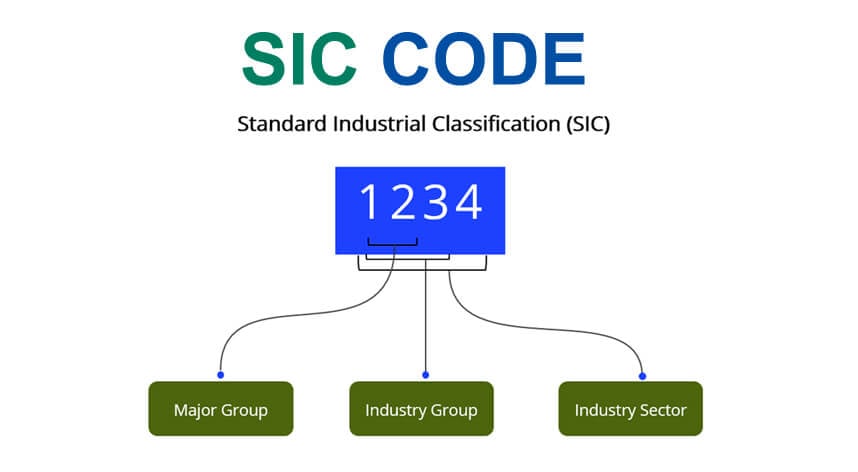- What is a SIC Code?
- Understanding the categories in Standard Industrial Classification (SIC) Codes
- How are SIC Codes Used?
- SIC codes vs. NAICS Codes: Exploring the Differences
- How to Interpret SIC Codes?
- How Can I Find the SIC Code for a Company?
- In conclusion
Contact Us for Marketing Campaigns
What is a SIC Code?
The U.S. government assigns Standard Industrial Classification (SIC) codes, four-digit numerical identifiers that classify the industries to which corporations belong, and arrange industries according to their commercial activity. To categorize and analyze economic activity across multiple businesses and government associations and to improve uniformity in the presentation of statistical data gathered by various government agencies, the U.S. government developed the SIC codes in 1937. The SIC code listing has also been adopted abroad, especially in the United Kingdom.
However, the North American Industry Classification System, a set of six-digit codes, mostly supplanted the Standard Industrial Classification codes in 1997. (NAICS). The North American Free Trade Agreement (NAFTA), signed by Canada, the United States, and Mexico, called for using the NAICS codes to standardize industry data collecting and analysis. Government organizations and businesses still use the SIC codes today to categorize the industry that enterprises belong to by matching their commercial activity with similar businesses, despite having been replaced.
Understanding the categories in Standard Industrial Classification (SIC) Codes
Here is a list of SIC code categories that may be found in various industries:
Each of these contains 3 digit SIC code that corresponds to four-digit industries.
These are classified into 83 two-digit major groups, 416 three-digit industry groups, and more than 1,000 four-digit industries. Every industry has a primary SIC code that identifies its major line of business. The SIC code's first two digits designate the primary industry group, the industry group's third digit, and the specific industry's fourth digit.
The SEC is a key government organization in charge of market regulation. The SEC continues to use SIC codes. The SIC code lookup by company name is used to identify a company's industry in electronic data gathering, analysis, and retrieval system filings.
How are SIC Codes Used?
SIC codes are used by businesses and the government in various ways, as detailed below.
Businesses
- Companies utilize SIC codes to locate existing and future clients based on their industry.
- Companies can be classified using SIC codes for tax purposes.
- When issuing credit, banks and creditors utilize SIC codes to identify the industry to which a company belongs.
- Professionals and corporations utilize SIC codes to establish customized marketing strategies.
- Companies can locate competitors in their industry or location by looking for similar businesses using SIC codes.
- SIC codes are also used by businesses to identify government contracts.
Government
- The government uses SIC code lookup to organize essential economic data for numerous federal and state agencies and private businesses.
- SIC codes facilitate data comparison across several government entities.
- SIC codes are also used to classify taxes.
- When sorting corporate filings, the SEC employs SIC codes.
SIC code vs. NAICS: Exploring the differences
The SIC codes lookup system is still the most widely used industry classification system. The long history and the reluctance of businesses associated with long-term users of SIC codes cannot move to a new classification system. The NAICS codes are unable to replace it fully. Although the United States government stopped updating SIC codes in 1987, commercial data groups stepped in and continued to maintain the SIC system, including creating very detailed extra classes. As a result, over 10,000 six-digit SIC codes are currently at the highest defined levels (compared with 1,066 NAICS codes). Because of the increasing degree of integration within the North American economy after the implementation of NAFTA, U.S. corporations now have both SIC and NAICS codes.
How to Interpret SIC Codes?
Each number in a SIC code has significance; to read a SIC code, each pair of digits must be evaluated independently to discover the overall meaning of the code.
The First and Second Digit
The initial two numbers of a SIC code identify the principal sector group of a business. Although the number of significant groupings varies, there are usually fewer than 100 big organizations. These large groupings fall into one of the 11 major divisions, and the first two digits describe the company's industry.
The Third Digit
The third digit is the second distinct trait that characterizes a corporation. This third digit refines the business classification and is also known as the business industry group. For instance, if code 23xx relates to clothing companies:
- 232x distinguishes between men's and boys' furniture.
- 233x recognizes women's and misses' furniture.
The Fourth Digit
A company's most specific identity is the last digit of its SIC code. With this last digit added, there are now over 1,000 possible possibilities. SIC code 2050, for example, covers bakery products, while SIC code 2052 represents cookie and cracker makers. This fourth number narrows the business classification further into a highly precise business category.
Buy 100% Opt-In Job Title specific Lists
Contact Us for Marketing Campaigns
How Can I Find the SIC Code for a Company?
The Securities and Exchange Commission of the United States publishes a standard code list that can be used to determine a SIC code. The Division of Corporation Finance specially reviews and updates the code list. Here's an example of interpreting the SIC code. Apple Inc.'s SEC filings state that its SIC code is 3571 (electronic computers). The first two digits—35—define its major industry group as "Industrial and Commercial Machinery and Computer Equipment," while the third digit—7—defines it as "Computer and Office Equipment," and the last digit—1—defines it as "electronic computers." It is worth noting that if the first two digits are between 20 and 39, the company is defined as being in the manufacturing division or sector of the economy. Despite the fact that NAICS has replaced SIC codes, they can still be searched for.
In conclusion
The Securities and Exchange Commission offers a list of SIC codes to assist in identifying the proper reviewer of company filings based on the industry in which a company operates. When releasing reports, companies must declare the SIC code best describes their activity. Analyzing a NAICS or SIC Code can provide organizations with the same benefits. Similarly, real estate companies use NAICS and SIC codes to evaluate possible investment locations better. If a business next door to a possible investment site is designated as an industry incompatible with the proposed investment, the firm's decision may be influenced. Real estate firms can make better investment selections by identifying which sectors are active in a specific place. The public sector analyzes data using NAICS and SIC codes as well. Government agencies use NAICS and SIC codes to inform budgeting, resource distribution, and zoning. Using standardized codes across geographies, whether domestic or international, simplifies the approach and improves accuracy.





